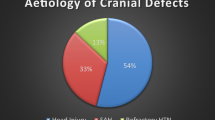Abstract
Introduction
The patients with cranial deformity suffer from headache, dizziness, irritability, loss of concentration, depression, anxiety, intolerance to noise and vibration and neuromotor weakness. It is therefore essential to restore the calvarium.
Material and Method
This study was conducted in the Department of Oral and Maxillofacial Surgery, Armed Forces Medical College, Pune between Oct 2010 and Mar 2012. The study population was selected from the outpatient department and from the referred cases. The aim was to study the uptake of split thickness calvarial graft in the management of residual cranial defect. After applying the inclusion and exclusion criterions, ten cases were selected with residual cranial deformity, operated for cranioplasty using split thickness calvarial graft and evaluated.
Conclusion
It was concluded that cranioplasty using autogenous split thickness calvarial graft for restoring cranial defects is a useful technique and this procedure allows the surgeon to reconstruct a moderate-to-large cranial defect, without breaching the inner cortical plate.







Similar content being viewed by others
References
Rish BL, Dilon JD, Meirowsky AM et al (1979) Cranioplasty: a review of 1030 cases of penetrating head injury. Neurosurgery 4:381–385
Paul B, Lachlan MC, John LR (2009) The Leeds method for titanium cranioplasty construction. Br J Oral and Maxillofac Surg 47:238–240
Fodstad H, Love JA, Eksted J, Friden H, Liliequist B (1984) Effect of cranioplasty on cerebrospinal fluid hydrodynamics in patients with the syndrome of the trephined. Acta Neurochir (Wien) 70:21–23
Ahmet A, Deniz B (2007) The earliest document regarding the history of cranioplasty from the ottoman era. Surg Neurol 68:349–353
Jackson IT, Helden G, Marx R (1986) Skull bone grafts in maxillofacial and craniofacial surgery. J Oral Maxillofac Surg 44:949–955
Akira I, Susumu S, Kentarou S et al (1995) Cranioplasty with split thickness calvarial bone. Neuro Med Chir 35:804–805
Eric WS, Daniel LS (1996) A new method of acrylic cranioplasty. Surg Neurol 46:292–294
Kulali A, Suat K (1991) Single-table autogenous calvarial grafting for cranioplasty. J Craniomaxfac Surg 19:208–211
Ramon LR, Timothy AT, Bernard JC, Tinerfe JT (2005) Cranial bone grafts: craniomaxillofacial applications and harvesting techniques. Atlas Oral Maxillofac Surg Clin North Am 13:127–137
Salvatore C, Di Rocco Fedreico, Giuseppe M et al (2010) Decompressive craniectomy and early cranioplasty for the management of severe head injury: a prospective multicenter study on 147 patients. World Neurosurg 34:558–563
Rifkinson MS (1988) Cranial surgery in ancient Peru. Neurosurgery 23:411–416
Zins JE, Whitaker LA (1983) Membranous versus endochondral bone: implications for craniofacial reconstruction. Plast Reconstr Surg 72:778–784
Moss SD, Joganic E, Manwaring KH, Beals SP (1995) Transplanted demineralized bone graft in cranial reconstructive surgery. Pediatr Neurosurg 23(4):199–204
McCarthy JG, Zide BM (1984) The spectrum of calvarial graftings: introduction of the vascularized calvarial bone flap. Plast Reconstr Surg 74(1):10–18
Firtell David N, Grisius Richard J (1981) Cranioplasty of the difficult frontal region. J Prosthet Dent 46(4):425–429
Bradley ES, Thomas M (2000) Calvarial bone graft harvest: a new technique. Otolaryngol Head Neck Surg 123:547–552
Josan VA, Sgouros S, Walsh AR et al (2005) Cranioplasty in children. Childs Nerv Syst 21:200–204
Kyoshima K, Gibo H, Kobayashi S, Sugita K (1985) Cranioplasty with inner table of bone flap. J Neurosurg 62:607–609
Chen TM, Tsa JC, Burnouf T (2008) Cranioplasty using osteoconductive scaffold and platelet glue. J Trauma 65:1321–1327
Arnaud E (2000) Advances in cranioplasty with osteoinductive biomaterials: summary of experimental studies and clinical prospects. Childs Nerv Syst 16:659–668
Author information
Authors and Affiliations
Corresponding author
Rights and permissions
About this article
Cite this article
Rangan, N.M., Sahoo, N.K., Tomar, K. et al. Efficacy of Autogenous Split Thickness Calvarial Graft in the Management of Residual Cranial Defect. J. Maxillofac. Oral Surg. 14, 754–760 (2015). https://doi.org/10.1007/s12663-015-0747-8
Received:
Accepted:
Published:
Issue Date:
DOI: https://doi.org/10.1007/s12663-015-0747-8




